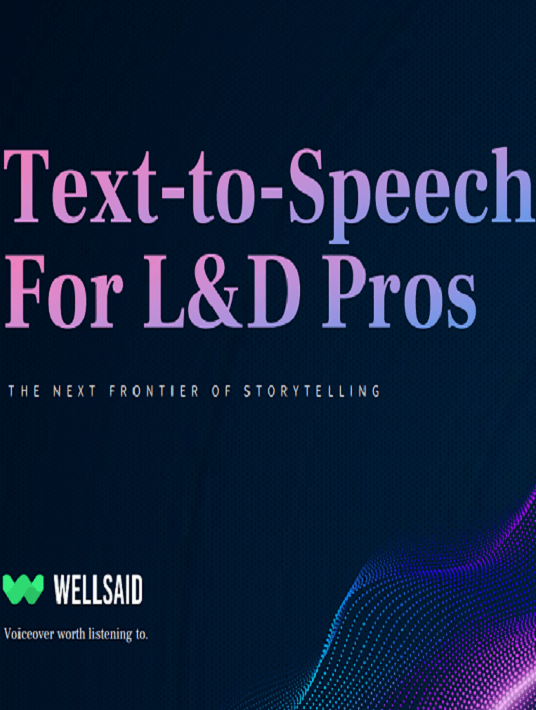What Is Text-To-Speech And How Does It Benefit L&D Professionals?
When you imagine computer-generated voices, you might think of a few familiar subjects: Siri robotically telling knock-knock jokes on command, Roomba warning you to watch out before she sweeps over the cat’s paws, or legacy text-to-speech that reads training content so robotically that no employee wants to listen to it.
But there’s a new generation of text-to-speech that forgoes the robotic intonations, and sounds not just human-like, but unmistakably human, so much so that listeners can’t tell whether the voice is a voice-over artist or a robot. (Or, well, both.)
These developments have massive implications for the learning and development (L&D) industry, which up until now, has had to use voiceover artists, agencies, or employees to record training content. In this chapter, learn what text-to-speech is and explore its benefits for L&D pros like yourself.

The Challenge Of L&D Pros: Making Magic Out Of Mayhem
L&D professionals have a tall order. They have to take immense amounts of information—often of a complex or dry nature—and turn it into engaging, understandable, digestible nuggets that keep employee attention, reflect the brand in a positive light, and ensure employees actually understand what they’re watching or listening to. All in a day’s work, right?
To make matters even more challenging, it can be difficult to find the right voice to bring your content to life. Most companies are faced with either shelling out thousands of dollars to an agency for voiceover work, tracking down just the right voiceover artist, or finding an employee with a decent voice and buttering them up with enough caramel macchiatos that they’re willing to record a few lessons.
Then, even if you manage to find the right voiceover artist, you’re typically out of luck when content inevitably needs a refresh. Now, you have to track down that same artist to swap out a few words and pay a few hundred bucks to do so, (That is, if you can even locate them to begin with.) It’s inefficient, it’s ineffective, and it’s a royal headache.
Fortunately (cue the computer trumpets) text-to-speech to the rescue.
What Is Text-To-Speech?
Imagine a voice so lifelike that you honestly couldn’t tell whether it was, in fact, a human voice or an algorithm from the future. The transitions sound natural, the inflections are oh-so-smooth, and the voice is upbeat, or sensible, or serious—your choice.
Imagine that you could select from these voices and personalities the way that you would any other voiceover artist. Good news: text-to-speech is here, and it is all these things and more.
Text-to-speech is a type of technology that reads digital text aloud. With just a click of a button, text-to-speech can translate words on a digital device into human-sounding audio. Artificial intelligence continues to evolve what can be accomplished with speech synthesis, making text-to-speech acceptable (and attractive) for creative productions.
6 Benefits Of Text-To-Speech For L&D Pros
Below are a few benefits of text-to-speech for the L&D world in particular.
Benefit #1: Quality
Learning and development content is often the first touch-point an employee has with a company when they come onboard. Text-to-speech helps you create high-quality, interactive, entertaining training modules, positioning your brand as professional, current, and competitive.
Benefit #2: Engagement
It’s no small task turning content about cybersecurity, legal compliance, or harassment into something that hooks employee attention and keeps it through several modules. But with a more natural, human, high-quality sounding voice, it’s a lot easier. Suddenly, your modules come to life, your employees are engaged, your content does its job, and your workplace is safer and more secure. Everyone wins.
Benefit #3: Employee satisfaction and retention
The next generation of employees grew up with smartphones at their fingertips, so they set a high bar when it comes to technology expectations. To be a competitive employer in the 21st century, your L&D materials can’t look or sound like they came from the 1900s. With modern text-to-speech, your content can position your company as the in-demand place to be, work, and grow an entire career.
Benefit #4: True comprehension
It’s not just about entertaining your employees. It’s about making sure they grasp complex topics and can internalize them as part of your company’s process. With high-quality text-to-speech, you can create materials that employees better absorb and implement.
Benefit #5: Cost-savings
Traditional methods to produce voiceover are expensive. Paying for a voiceover to change a few words every time you need a content update is downright inefficient. It’s simply not cost-effective to create and update content that way. With text-to-speech, you can pay a flexible fee to convert your content to audio when needed, similar to how you would easily pay to transcribe a podcast episode.
Benefit #6: Workflow efficiencies
Not only is it time-consuming and expensive to manage a voice production process, but retakes and content updates can slow down your entire schedule. You can’t afford to squeeze yourself back onto an agency’s calendar every time you need a content update, and tracking down a coworker in another department to cover for you isn’t exactly efficient, either. Text-to-speech enables you to quickly upload your content online, then receive an audio version—no calendar scheduling, booking appointments, or renegotiating contracts required.
Conclusion
Text-to-speech provides a fresh alternative to L&D departments looking to cut down on the time, cost, and complications of recording voiceovers for training content. With the new frontier of human-sounding text-to-speech, L&D professionals can translate their content into natural speech with the client of a button—creating a more efficient workflow, high-quality product, and better employee experience all around.
Download the eBook Text-To-Speech For L&D Pros: The Next Frontier Of Storytelling to learn how to leverage AI voice generators for your remote learning programs and boost employee engagement. Also, join the webinar to learn how you can update eLearning voiceovers on time and under budget!

